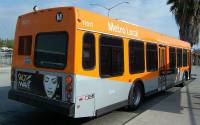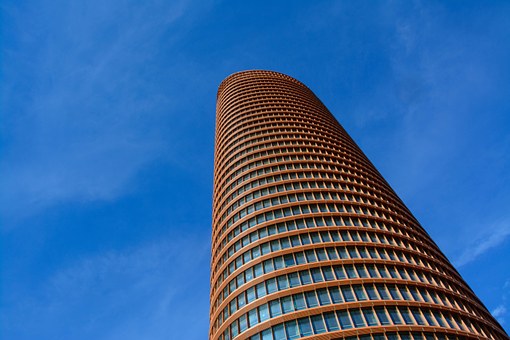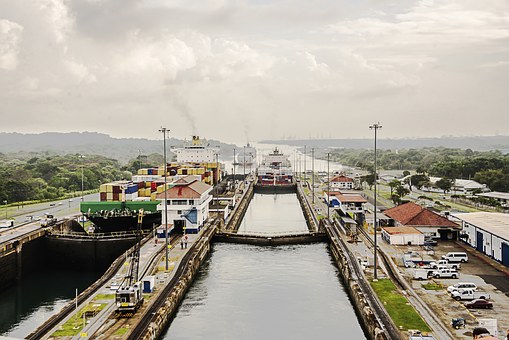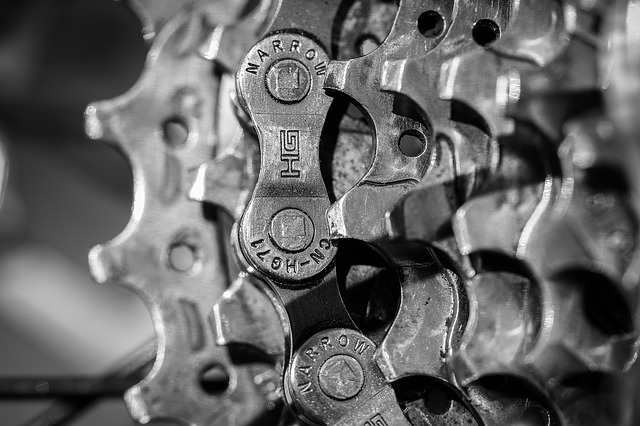Photochemical smog, created by any gasoline-powered vehicle on the road, is a major concern in Los Angeles today. Buses, despite being implemented to reduce this pollution by lessening the number of cars on the streets and freeways, are smoke-spewing machines that pose a risk to environmental and public health. They are also inefficient; most Los Angelenos opt to continue using their cars because of the long wait time and lack of punctuality of bus transportation. One solution that this article with discuss is The Gold Line, a new railway that will hopefully reduce dependence on cars and alleviate freeway congestion.
The Problem
On some days, one is barely able to see the sun in Los Angeles–a city ironically famous for its sunny skies. The cause is a phenomenon familiar to Angelenos – photochemical smog – created by the millions of cars, trucks, and other gasoline-powered vehicles traveling through the large urban area. Smoke-spewing buses used for public transportation are thus a major concern here, as they pose a risk to the environment and to public health (see Fig. 1). This sharply contrasts with one of the aims of public transportation, namely the reduction of smog by lessening the number of cars on the streets and freeways. The supposedly environmentally-friendly bus system, a solution implemented by civil engineers decades ago, has compounded this problem.
The Irony of Environmentally-Friendly Buses
Overcrowded buses have led to demands by frequent riders for more buses. Though increasing the number of buses in Los Angeles will not have a positive impact on the existing poor air quality, such a solution appears more viable when contrasted with the costly new rail systems being implemented. Additionally, the use of alternative bus fuels could mitigate environmental problems. However, the railway systems come with positive side-effects, because they do not pollute as the buses do and do not add to motor-vehicular traffic. If more public interest is stimulated, underground and surface railways could become a valuable transportation resource for this car-congested metropolis.
Most buses used for public transportation in Los Angeles and around the nation run on diesel gas. Burning this unclean fuel releases toxic particles and noxious gases, such as nitrogen and sulfur oxides and ozone gases, into the air. These chemicals interact with the environment in a process called thermal inversion. This trapping of noxious air by ocean currents and mountain barriers causes the distinctive yellow-brown coloring of Los Angeles’ troposphere. The Sierra Club explains the negative effects of buses:
“The bus’s major drawback, in fact, is its reliance on polluting diesel technology. More than 92% of U.S. buses are diesel powered; even new ones create as much smog as 50 cars, and spew as much soot as 279 cars. These tiny soot particles (also known as particulates) collect in the eyes and nose and worsen respiratory problems, especially in children, the elderly, asthmatics, and people with heart or lung disease.\Motovalli\
The Los Angeles Metropolitan Transit Authority [1] is aware of these findings and has begun to replace old diesel buses with newer buses that run on natural gas. According to Alternative Fuel News and the Los Angeles Times, L.A. has a higher number of natural gas-powered buses than any other U.S. city. Yet, despite this, L.A. continues to be one of the nation’s worst smog-ridden cities.
Wasted Potential
Unfortunately, many Angelenos do not take advantage of the public transportation system; few are persuaded to give up their cars to ride the bus or rail. Some do not like the wait, which can range anywhere from 20 minutes to one hour. Some dislike the complicated transfer system, as one often has to transfer up to three or four times to reach a certain destination. Others fear the “strange” people who ride the bus. Whatever the reason, many residents, particularly those in the middle- and upper-classes, do not use the Metro to its full potential. The exhaust from their cars perpetuates the city’s smog problem.
Recently, the American Society of Civil Engineers issued a report card regarding the infrastructure of Los Angeles. The transit system was given a C+, a barely decent score. Though ASCE rates the equipment of the metro system well and has noted that the “light and heavy rail systems include an array of relatively new stations, maintenance facilities, and vehicles,” it also observes that, “a vast majority of the county’s bus fleet is operated and maintained in outdated facilities.” The ASCE also finds the effectiveness of the public transit system to be poor. [2].
The Gold Line
Roger Snoble, Chief Executive of the L.A. Metropolitan Transit Authority [1], justifies the current major spending on the new Gold Line rail project: “I drive the freeway enough to know we need to get this line up and running as soon as possible, to give people another option.” The MTA does have seemingly valid reason to invest heavily in the construction of the new rail system, the Gold Line, which would run through downtown L.A. and Pasadena (see Fig. 2). Building another underground railway, says the MTA, would help to reduce dependence on cars, due to the subway’s superior speed and cheap operating costs once built [3]. Businesses along the route believe it will boost sales.
The railways will hopefully improve the state of transportation engineering in Los Angeles. Freeways have been widened to such an extent that there is little room for greater expansion. In fact, Los Angeles and its vicinity contain 27 freeways; rather than alleviating traffic problems, the massive number of interstate highways has only encouraged more drivers, causing a civil engineering nightmare. Underground railways detract from the motor vehicle congestion problems by luring residents away from their private vehicles through a more convenient method of public transportation. If the MTA can finish building more railway lines in areas accessible to a greater population, they might succeed in engineering a solution to L.A.’s infrastructural flaws.
Though the future of the railways is painted bright, the Gold Line does have its drawbacks. In certain areas, like Chinatown, the Gold Line surfaces above ground and hovers directly above the historically significant district. This has led to concerns from residents regarding possible noise pollution, as well as safety issues. The trains are more than just loud – recent child deaths at railway intersections raise concern. Journalist Kurt Streeter notes, “most Los Angeles-area residents are not used to seeing light-rail trains running on streets and mixing with cars and pedestrians, which the Gold Line does at several points along its route.”
The MTA has also come under scrutiny due to its decision to fund the rail systems more heavily than the buses. Public transportation disputes over the MTA-favored rails and the more commonly used buses have sparked complaints that the MTA is suspect of environmental racism, since the MTA has repeatedly been in favor of projects that would primarily benefit Caucasian communities, such as rails and subways that link suburban areas to downtown’s financial district [4].
However, minority and working-class groups are the largest users of the L.A. transit system. Those working in the financial district typically arrive to their work destination by personal car and have shown little sign of giving up this mode of transport. Statistics on MTA’s website reveal that, while yearly boardings for the buses in 2002 totaled 125,276,211 people, the current rail systems, the Red, Blue, and Green lines, handled a mere 24,624,602 passengers for the same year–16% of the total transit riders. According to an article by Karen Klabin of the Los Angeles View, “of the 350,000 daily bus riders, 60 percent have annual family incomes of less than $15,000; 57 percent are female; 81 percent are people of color; and the majority of the white bus riders are either elderly or disabled.”
The Bus Riders Union of Los Angeles (BRU), a non-profit organization, argues that the Metropolitan Transit Authority [1] is unjust in opting to implement expensive, new light rail systems rather than increasing the number of buses that run the most popular routes, thereby alleviating crowded bus problems. Bus rides through South and East Los Angeles can become so crowded that passengers cannot see out the window, inhibiting their abilities to know at what stop they are located. Drivers are often forced to pass bus stops without picking up passengers, because the bus is well over its intended maximum human capacity already. Motavalli notes, “Overcrowding of 140 percent is typical on MTA bus lines, but unknown on the light-rail routes that link middle-class suburbs to downtown.” Civic-Strategies, Inc., also mocks the MTA’s decision to fund subways over buses:
“Los Angeles has built a dream subway system. It’s cheap ($1.35), clean and safe, and the subway stations are stunning. It’s also a financial and transportation nightmare. It lured few commuters off the roads and cost $4.7 billion to go 17 miles. In 1998, voters forbade any more local money for construction.\Motovalli\
Members of the BRU also realize the negative environmental impact of diesel-powered buses and have pushed for more vehicles fueled by natural gas [4].
Solutions for the Future
With so many complicated economic, social and environmental issues surrounding public transportation, it is hard to discern which solution is truly ethical. The most practical choice would be to deploy more buses in areas with frequent riders, rather than spending so much money on rail systems that contain a far fewer average number of passengers. If funding allows, the optimal solution would be to both increase the number of buses fueled by natural gas while simultaneously finishing the building of the rail system. However, unless the MTA can persuade residents to leave their cars at home, such high-scale projects will not benefit anyone and will seriously hurt working-class neighborhoods that are suffering as a result of crowded buses and intense smog.
Meanwhile, the Bus Riders Union, as well as environmental organizations like the Sierra Club, continue to lobby the MTA until a “morally just” public transportation system is implemented. As stated by Robert Garcia for Environmental Defense, “For many supporters, it may have mattered less whether the motivating factor was civil rights, the environment or efficiency – their common cause was to do what’s right, which ultimately serves all these ends.” For the engineers who have struggled to find solutions to L.A.’s horrible traffic problems, the rail system is like a dream come true. Referring to the impressive rail development currently taking place over Chinatown, Rick Thorpe, overseer of the Gold Line railway project, remarked, “Look at that! The future looks good.”






